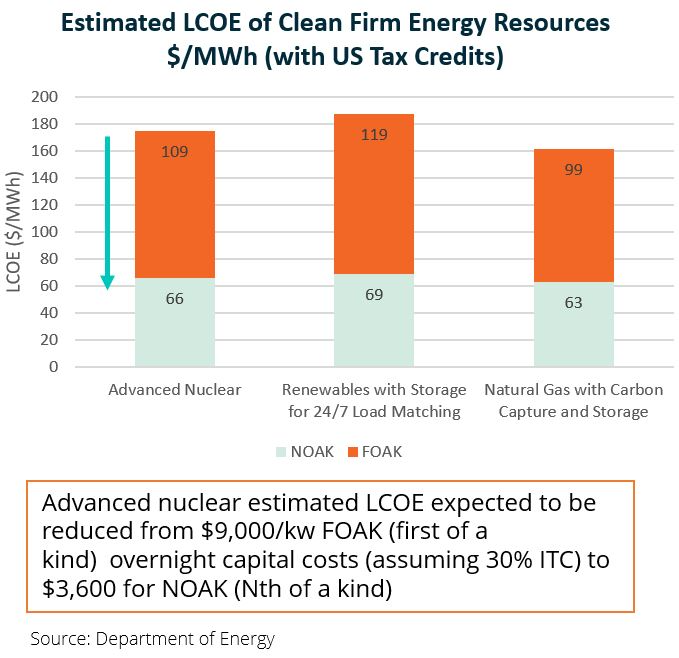Will Small Modular Reactors Surpass Regulatory and Supply Chain Hurdles to Fill the Need for Stable, Baseload Power?
Global energy demands are expected to increase dramatically over the next few years. For decades, experts suggested estimates that 2050 could require twice or triple the energy generation we produce today. But what will bridge the gap to meet these needs? Even if we were to exclusively rely on wind and solar for decarbonized power, there would still be challenges with storage and transmission. Certain use cases would also require consistent stable baseload power and cannot rely on intermittent sources like wind and solar.
Nuclear power plays a significant role in getting to net-zero goals and providing customers with ways to generate power onsite, however, there are known challenges. Nuclear power’s popularity fluctuates with opponents citing high capital expenditures, hazardous waste production, and storage and licensing timelines.
Advanced nuclear, small modular reactor (SMR), and microreactor developers are creating solutions that overcome many of the traditional challenges of nuclear power.
Opportunities and Challenges for Small Modular Reactor Development
Small modular reactors and microreactors provide several benefits when compared to traditional nuclear power plants. These advantages include smaller land footprints, enhanced safety mechanisms, lower costs, and shorter lead times. Costs for SMRs vary, but estimates suggest that depending on the size, smaller reactors can cost between $50M for microreactors to $3B for larger units.
Microreactor outputs can range between 1-20MW and SMRs can range between 60-300MW. Gen III reactors utilize pressurized light water technology which is used in traditional plants but at a slightly smaller scale. These projects use water as a coolant and LEU fuels which can be made available in most countries. Estimates suggest that CAPEX costs for these reactors can be up to $5,000/kW with a levelized cost of electricity (LCOE) ranging between $80-$90/MWh. For comparison, offshore wind costs between $3,000-5,000 per kW to construct, and utility scale solar costs between $700-$1,500 per kW in the U.S. (Statista).
While some reactor costs are high, innovators are looking to reduce costs by developing new reactor designs and technologies using various coolants and fuel types for Gen IV reactors. Costs for these reactors vary but some suggest they can be reduced to $2,500/kW for upfront CAPEX costs and LCOE costs around $35/MWh if they were to scale.
Despite the attractiveness of these technologies, there are numerous hurdles that need to be overcome for SMRs to succeed. One of the most visible setbacks to the industry can be seen tracking NuScale’s project developments in the U.S. NuScale had initially quoted costs close to $58/MWh to customers but then had to revise their estimates to $89/MWh. Higher costs can be attributed to higher material costs, in particular, costs for things like reinforced concrete have gone up considerably. This led to the very public discontinuation of the Carbon Free Power Project (CFPP). However, NuScale will continue to build out projects in Eastern Europe and elsewhere and develop learnings.
There are multiple projects underway in Europe, Canada, and the U.S., but only one SMR is currently connected to the grid in China. One of the biggest challenges SMRs need to overcome before commercializing involves getting these new reactor designs licensed. While theoretically Gen III reactors that resemble traditional reactors should be able to get licensed faster, we still have yet to see an SMR design get licensed in Canada or the U.S.
Scaling Nuclear
Despite these setbacks, there is a thriving landscape of innovators developing new nuclear technologies. This is because nuclear power is still one of the best solutions to provide carbon-free baseload power. Lower operating costs will make nuclear attractive in the long run. If SMRs are able to get the CAPEX down considerably they will play a sizable role in the future of nuclear technologies.
This is true especially as nuclear technologies look to address certain applications that require high heat. Many industrial processes, green steel, and green hydrogen production, require industrial heat. If nuclear technologies can provide pathways to decarbonize these industries, they can tap into markets that traditional nuclear was unable to previously. For example, X-Energy is partnering with Dow Chemical to use their high temperature gas cooled reactor to decarbonize chemical manufacturing at their Seadrift industrial site in Texas.
Additionally, SMRs can play a critical role in supporting data centers, desalination sites, and district heating centers. They can also be used to repurpose existing coal sites and produce clean steam to power the centers.
Innovation in Small Modular Reactors and Microreactors
- Liquid Metal Cooled Fast Reactors. These operate at higher temperatures and lower pressures and use fast neutron technology; many use sodium as a coolant (e.g., Arc Clean Technology)
- Molten Salt Reactors. Molten fluoride or chloride salts are used as coolants and produce shorter lived radioactive waste than other reactors (e.g., Terrestrial Energy, Moltex Energy, and Core-Power)
- High Temperature Gas Cooled Reactors. Flowing gas allows for higher electricity generation and enhanced safety features (e.g., X-Energy and Ultra Safe Nuclear Corporation.

Looking Ahead
As licensing technologies remain a critical step in getting new nuclear on the grid, the first companies to be licensed in the U.S. and Canada will be very telling in setting a trend as to which types of technologies can expand and commercialize.
Additionally, challenges with securing HALEU fuels required for many SMRs may prevent growth and development as seen with the delays for TerraPower’s first plant in Wyoming.
As companies like Kairos Power, X-Energy and Nano Nuclear work on developing the supply chains for HALEU fuels, other companies like Moltex Energy which develop advanced reactors using spent fuel or LEU fuels, may also find success leveraging available fuels.



